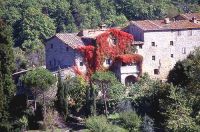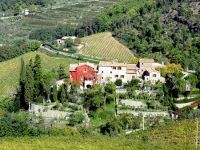Castello di Lamole - Castle of Lamole in Chianti
Since at least the year 1000, the Castello di Lamole has stood on a spur above the valley of the river Greve , just off what is now the road from Greve to the village of Lamole and onwards to Monte San Michele and the Siennese territory around Radda. Although the Castle of Lamole was part of the defence network on the border between the territories of Florence and Sienna, as for many other settlements of this kind, its historical origins are lost among the obscure events of the 10 C to 12 C that led to the mediaeval phenomenon of “incastellamento” (fortification) of rural settlements. The borgo has an eliptical shape about 600 m in circumference and most of the original castle walls have long since been incorporated into those of the houses. However, the ancient walls are still visible on the NW side. The village is traversed length-wise by two narrow streets connecting three tiny squares.
New buildings have been built upon the mediaeval structures. The ruins of the defence walls, knocked down during the wars, have been dismantled and their stones used in other buildings. The steep ground around the Castle has been terraced for vineyards, olive trees and iris cultivation. The chestnut woods with their timber and nuts became a major economic resource for the inhabitants.
Elena Spolaor
Castello di Lamole in the Middle Ages
In 1250, the Castle of Lamole became the seat of the town of Lamole and part of the Val di Greve alliance, heir to the ancient Chianti alliance responsible to Florence for the control and defence of the Chianti region. During the 14 C and 15 C, the Castle of Lamole, together with the Castle of Panzano, was probably one of the most important military centres in the territory. The two castles were similar in terms of the structure of the fortified settlement distributed around a few important buildings, of the typically mediaeval architectural development of tower-houses and of the main entrance to the castle. The main portal of the Castello di Lamole, similar to that of Panzano in dimensions and the type of stone used, has been found inside one of the castle's buildings and awaits restoration.Castello di Lamole during the Renaissance
A Florentine document dated 23 August 1478 relates that during the advance of the Aragonese troops against the Siennese, the Castle of Lamole was captured and burnt out. It was rebuilt after Florence won the war against Sienna and once more became a link in the chain of Florentine control of the territory, carrying out its administrative role during the whole 16 C under the seigniory of the Medici. As its military significance faded with the final subjection of Sienna, the Castle saw its towers and its “luxury houses” become farmhouses, taking on their present appearance.New buildings have been built upon the mediaeval structures. The ruins of the defence walls, knocked down during the wars, have been dismantled and their stones used in other buildings. The steep ground around the Castle has been terraced for vineyards, olive trees and iris cultivation. The chestnut woods with their timber and nuts became a major economic resource for the inhabitants.
Castello di Lamole in modern times
After the Second World War, there was a major movement of the Italian population from the countryside to the cities, and a great many rural houses and farms were abandoned. This took place throughout the Chianti zone, including in the area around Lamole. In the 1970s, the major part of the Castello di Lamole was bought by Vincenzo Marasco, an engineer, who began restoring it. Many interesting features were uncovered during restoration, including a mediaeval window with a seat in it and the main portal. The borgo still belongs in large part to the descendents of Vincenzo Marasco who have opened agriturismi and a restaurant.Elena Spolaor



